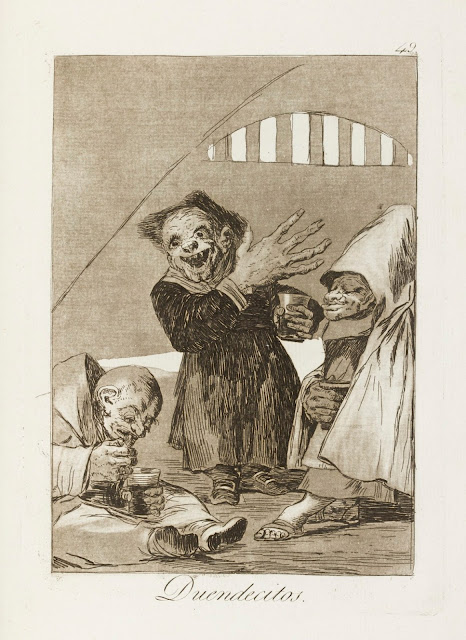Hobgoblins (Duendecitos) by Francisco Goya (Interpretation and Analysis)
 |
| Duendecitos Source: Royal Academy of Arts |
Hobgoblins (Duendecitos in Spanish) comes from Goya’s Caprichos, a series of prints created around the turn of the century. These prints present a satirical image of Spanish society, criticizing the follies, superstitions, and ignorance of people from every walk of life. The creation of the Caprichos marks a major turning point in Goya’s artistic life. Throughout his early career, Goya worked as a court artist, focusing mostly on formal portraits and tapestry cartoons intended to decorate royal residences. Since this work was created for patrons, it was fairly conventional. Creating independent art, like the Caprichos, allowed Goya to express himself and experiment in a way that wasn’t possible in commissioned works.
While many of the Caprichos are enigmatic, Hobgoblins is an especially puzzling and charming image. The print depicts three monstrous, goblin-like creatures dressed in the garb of monks and clergymen. The creatures have long nails and pointed teeth, creating a gruesome yet entertaining appearance. The central hobgoblin also has a giant hand, which contemporary commentators interpreted as a sign of greed. The large hand takes all that it can hold.
While contemporary viewers made guesses about what the Caprichos might mean, nobody really knew what Goya intended to convey when he created them. There are a few competing interpretations for Hobgoblins. Most art historians understand Hobgoblins to be a thinly veiled attack on the clergy. Here, Goya depicts the clergy as lazy little monsters who live off the wealth and labor of ordinary Spaniards. As the Ayala manuscript—a contemporary commentary on the Caprichos— explains:
The priests and friars are the true goblins of this world. The church with its long hand and sharp tooth takes all that it can.According to my research, the term “long hand” was a common euphemism for theft. In this interpretation of Hobgoblins, the church is a predatory organization that impoverishes the Spanish people. Goya was also disdainful of the Inquisition and the superstitions that he felt the church propagated.
(Los curas y frailes son los verdaderos duendecitos de este mundo. La iglesia de mano larga y diente canino, abarca todo cuanto puede.)
The composition of the piece is also reminiscent of Están calientes, another Capricho in the series that mocks the clergy more explicitly. This lends additional credibility to the explanation presented above.
Alternatively, it’s possible to view Hobgoblins simply as a whimsical or fantastical image of mischievous little creatures enjoying some wine. In the Prado manuscript—a commentary on the Caprichos that most scholars believe was written by Goya himself—Hobgoblins is explained in more cheerful language:
These are the other people. Cheerful, playful, helpful and a little sweet, friends that will serve you a trick, but very good little men.It’s possible that both interpretations are valid. After all, the duendes of legend (dwarves or hobgoblins in English) are alternatively cruel or helpful to the humans they encounter, making them difficult characters to pin down. This same elusive meaning may be intentional in Goya’s work. Like most artists, he commonly created art that operated on several levels of meaning. In Goya’s case, it is likely that he needed a plausible explanation of his Caprichos that wouldn’t draw the ire or condemnation of the powerful church and aristocracy.
(Esta ya es otra gente. Alegres, juquetones, serviciales y un poco golosos, amigos de pegar chascos, pero muy hombrecillos de bien.)



Comments
Post a Comment